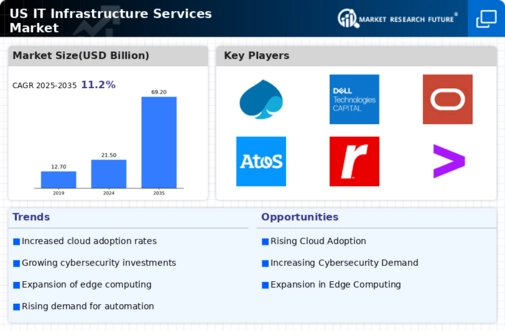The IT infrastructure-services market is currently characterized by intense competition and rapid evolution, driven by the increasing demand for cloud computing, data analytics, and digital transformation. Major players such as Amazon Web Services (US), Microsoft (US), and Google Cloud (US) are at the forefront, leveraging their extensive resources and technological capabilities to enhance service offerings. Amazon Web Services (US) focuses on expanding its cloud services portfolio, while Microsoft (US) emphasizes integration with its software products, creating a seamless ecosystem for users. Google Cloud (US) is strategically investing in AI and machine learning capabilities, which positions it as a leader in innovative solutions. Collectively, these strategies contribute to a dynamic competitive environment, where agility and technological advancement are paramount.
Key business tactics within this market include localizing services to meet regional demands and optimizing supply chains to enhance efficiency. The competitive structure appears moderately fragmented, with a mix of established giants and emerging players. This fragmentation allows for diverse service offerings, yet the influence of key players remains substantial, as they set industry standards and drive technological advancements.
In October 2025, Amazon Web Services (US) announced the launch of its new AI-driven analytics platform, aimed at providing businesses with deeper insights into their data. This strategic move is significant as it not only enhances AWS's service portfolio but also positions the company to capture a larger share of the growing analytics market. By integrating AI capabilities, AWS is likely to attract clients seeking advanced data solutions, thereby reinforcing its competitive edge.
In September 2025, Microsoft (US) unveiled its partnership with several educational institutions to enhance cloud-based learning environments. This initiative underscores Microsoft's commitment to digital transformation in education, potentially expanding its user base among younger demographics. By aligning its services with educational needs, Microsoft is likely to foster long-term customer loyalty and drive future growth.
In August 2025, Google Cloud (US) expanded its data center footprint in the Midwest, aiming to improve service delivery and reduce latency for clients in that region. This expansion reflects Google Cloud's strategy to enhance its infrastructure capabilities, which is crucial for maintaining competitiveness in a market where speed and reliability are increasingly valued. Such investments are indicative of a broader trend towards regional optimization in service delivery.
As of November 2025, the competitive landscape is increasingly defined by trends such as digitalization, sustainability, and the integration of AI technologies. Strategic alliances are becoming more prevalent, as companies seek to combine strengths and enhance their service offerings. Looking ahead, competitive differentiation is likely to evolve from traditional price-based competition to a focus on innovation, technological advancements, and supply chain reliability. This shift suggests that companies that prioritize these areas will be better positioned to thrive in the future.























Leave a Comment